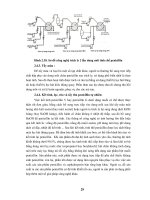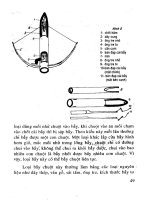Mapping Geomorphological Environments Phần 5 ppsx
Bạn đang xem bản rút gọn của tài liệu. Xem và tải ngay bản đầy đủ của tài liệu tại đây (3.25 MB, 25 trang )
90
The development and stabilisation
of a dune depend on vegetation
which entraps the sand and reduces
the activity of aeolian energy. After
the development and stabilisation of
the dune, its migration towards the
land’s interior may possibly follow,
as its seaward side might be eroded
depositing its material along the
shoreline. When the Aeolian energy
exceeds the cohesion of the sand
layer or the resistance of vegetation,
large parts of the dune can possibly
be detached.
COASTAL
SEDIMENTS
The coastline consists of
sediments of different
classication (sand,
gravel, silt, blocks,
etc) which reect
the dynamics that
prevail in the coastal
environment. When the material of
a beach consists of homogeneous
and ne sediments, it is related to
an environment of low and constant
energy; however, if the material
is heterogeneous, it is related
to an environment with a highly
variable dynamic. The presence of
roundstones possibly indicates the
beach’s supply by a torrent. Such
material is often found in average
energy environments. Material like
sand or clay could have originated
from a deep submarine basin,
between 5-12
ο
, while the lee side
has a higher inclination which can
reach up to 20
ο
to 30
ο
.
Regarding their shape, it also has
high variety, from very simple to
composite forms. Thus, there are
crescent, longitudinal, matterhorn
dunes and also dunes which are
created by very complicated
combinations.
Dunes can develop in every subaerial
environment where loose material,
of sand grain size, are exposed to the
wind’s activity and can easily migrate
and accumulate in large masses.
Every obstacle on the ground, such
as protrusions, ditches, the presence
of vegetation etc, contribute to this
accumulation. Furthermore, the
presence of humidity may stabilize
the sand accumulation, beginning
the creation of a dune.
It is a fact that the coastal dunes
cover a very small area compared
to the vast areas of dunes which are
generated in the deserts. Coastal
dunes are generated where a broad
sandy coast exists; this is usually
characterised by a great tidal width
and rarely by rocky and steep coasts.
Many sand dunes originate from
older geological eras when sea level
was much lower than it is today.
The sand is transported towards
the land in a bouncing way, during
which the movement of grains is
accelerated after they are raised by
the wind. The wind speed is slower
close to the ground and faster as
we rise, since the ground’s friction
is reduced. When a cloud of sand
passes over an uneven surface, its
speed is reduced due to the loss of
energy. This results to the deposition
of transported material and leads in
the creation of a new dune.
Aberdeen-UK (by A. Vassilopoulos, N.
Evelpidou)
Mapping Geomorphological Environments
91
slope, while relatively high dynamic
pressures occur when waves of a
vertical front plunge on the cliff with
their top and their trough
simultaneously.
CUSPATE
FORELANDS
Cuspate forelands may
represent a high variety of landforms,
but most, when they are fully formed,
have a more or less triangular shape,
with the base of their triangle on the
coastline and the apex advancing
towards the sea. Their formation is
usually related to wave refraction
on a neighbouring submarine ridge
and to bilateral sediment supply.
In areas with convergence of the
coastal transported sediments,
where the sediments are provided
by both sides of the gradually
forming land extension, the created
cuspate forelands have more intense
seaward development.
since it can be transported over
great distances by sea waves and
currents, or it could have originated
from river mouths (i.e. deltas).
CUSPATE
COASTAL SLOPE
Steep coastal slopes
which occur as a result
of marine erosion. The
slopes’ resistance to
erosion is a function of
the wave energy and of
the cohesion of the
rocks which constitute the slopes.
One could mention that the erosional
role of sea waves is double, as it
does not only erode the base of the
slope’s front but also removes the
weathering products from its base.
When the weathering products are
accumulated at the slope’s front
base, its retreat will possibly slow
down or stop, since they protect it
from the incident waves. At a slope
front two types of pressures are
exerted; the one is related to the
weight of the incident sea mass
(static pressure) and the other one
depends on the wave type, which is
a function of the waves’ dimension
and of the inclination of the slope
front (dynamic pressure). We have
the lowest dynamic pressures when
the waves are fully reected or when
they break before they reach the
Sporades-Greece (by A. Vassilopoulos,
N. Evelpidou)
Samos-Greece (by C. Centeri)
Coastal Environments
92
FLOODED FLUVIAL
VALLEYS - RIA
BEACHES
These belong to primary coastlines,
and owe their formation to sea
impact on a landform created by
terrestrial factors. They are identied
by the shallow waters of the valleys’
sunken rivermouths which cut the
land serrately, presenting a rich and
complex horizontal dissection. When
not interrupted by some natural
barrier, their axes dip towards the
sea. The characteristic types of Ria
coasts are the dendritic type, the
shape of which resembles an oak
leaf and is due to the uvial erosion
of horizontal layers of homogeneous
material, and the network type
which is due to the uvial erosion of
tilted layers of different hardness.
INCLINATION OF
THE COASTLINE
The distance from the
beach to the relatively at area
which comes after the beach front,
is a parameter which inuences the
inclination of the coastline, which is
measured in degrees or %. If this
distance is small, then the inclination
of the coastline is high and the beach
is qualied as steep; however, if it
is big, then the coastline is qualied
as of gentle inclination. The rock
beaches are usually distinguished
by steep inclinations, while the sand
beaches by more gentle inclinations.
LONG SHORE
CURRENT
A very powerful coast-
al current, due to which sediment is
transported along the shore.
LONGSHORE BARS
AND BEACH RIDGES
Landforms which look
like sand rumples, but are bigger
and have lower normal gradation.
They are usually created in shallow
epicontinental environments or on
the shelf borders, by the activity of
waves and coastal currents, and are
found individually or in groups. The
longshore or sand bars are classied
as longitudinal or transversal in
relation to the predominant coastal
current or the coastline.
Longitudinal longshore bars, are
found in river mouths, in funnel-
shaped river bays, in straits and
also in creeks, where the tidal effect
is observed. As far as transversal
Aigina-Greece (by A. Vassilopoulos, N.
Evelpidou)
Kavala-Greece (by Keramoti
municipality)
Mapping Geomorphological Environments
Kefalonia-Greece
(
b
y
K. Pavlo
p
oulos
)
93
period or in warm and humid areas,
where the development of dunes is
not possible. Since the sandy beach
ridges are directly connected with
fossil beaches, they sometimes
contain signicant accumulations
of heavy minerals of great nancial
value.
MARINE TERRACES
The continuous wave
activity in the coastal
zone generates a typical coast
prole, which consists of a sea
slope and a submarine terrace. The
sea slope begins as a low form,
whose height is increased towards
the inland, while it remains as a
submarine platform in its base.
The material which comes from the
slope’s weathering is transported by
the bottom currents and deposited
off the edge of the rocky terrace,
resulting to the creation of a terrace
generated strictly by the waves’
activity. Along some beaches, the
coastal currents are so powerful,
that the sediment coming from
inland erosion is carried away, so
that the only remaining landform
is the platform generated by sea
erosion. If the sea level remains
stable for a long time or if the rise
of the sea level happens extremely
slowly, the sea cliff will be quite far
ridges are concerned, the crescent-
shaped longshore bars, which
are found in river mouths and in
tidal creek channels, are typical
examples.
Longshore bars are formed of sand
that moves parallel to the coastline.
Particularly during low tide, they
may be uncovered and exposed
to atmospheric activity. Often
several longshore bars are formed,
in one or more series, which are
arrayed parallel to each other, and
at different depths in relation to
the sea surface. The term beach
ridges is used to describe a series
of longitudinal and parallel ridges,
consisting mainly of sand, shells
and roundstones , varying in width
from a few centimetres to a few
meters andat intervals of 25-500 m.
They are usually located behind the
contemporary beach. The ones that
are found in deltaic environments,
appear concentrated on a muddy
substratum and are known by the
term cheniers. Every ridge indicates
the position of the paleo-coastline.
Usually, the beach ridges are, as far
as their construction is concerned,
the natural evolution of some coastal
landforms, such as the longshore
bars or the cuspate forelands. Many
researchers consider that most
of the beach ridges which can be
found today were formed after the
stabilisation of the sea level at the
current levels, that is in the last
4.500-6.000 years approximately,
a period which coincides with
the Flandrian transgression. The
sandy beach ridges may possibly
contain also a percentage of
transferred aeolian material. This
however rarely occurs in places
where successive ridges have been
developed within a very short time
Kavala-Greece (by Keramoti
municipality)
Coastal Environments
94
MARMITE
Round ditch created by
the turbulent move-
ment of the roundstones which are
transported by waves or by turbu-
lent currents.
NOTCH
Formations located on
rocky coasts. They are
located in places where the sea
surface meets the land and are
created due to processes of friction,
solution or biological factors. Since
during the last years sea level is
rising, their presence above sea level
indicates tectonically active areas,
where the land is rising. Therefore,
by studying the sea fauna in these
notches, we collect characteristic
data for periods of constant rise
, for the rising rate and for the
earthquake risk of the studied area.
inland, while the terrace resulting
from the wave activity will be quite
expanded. If the evolution period is
shorter, this wave cut terrace will be
less wide. The changes in sea water
volume are not the only causes that
contribute to coastline changes.
If the sea level rises and reaches
a new level where it can remain
constant for quite a time period, a
new sea slope and a new platform
will be created. Thus, every period
of sea level stabilisation is followed
by the creation of a sea slope and a
platform. If the sea level is lowered,
its former levels will become
apparent through a succession of
terraces. The topographically higher
terrace, having sustained weathering
and erosion for a longer time period,
tends to become indistinct and is
usually represented by an increase
of inclinations at the locations where
the older sea slopes existed. The
terraces that were formed when the
sea level was on lower levels than
it is today, have been ooded when
the sea reached its current level.
As the rising sea has covered these
terraces, they will have suffered
considerable erosion by waves and
will have been partially covered with
material.
Samos-Greece (by C. Centeri)
Limbe-Cameroun (by K. Pavlopoulos)
Mapping Geomorphological Environments
95
SAND BEACH
A beach which consists
of ne-grained material,
the size of which varies from 50μm
up to 2mm.
SEA ARCH
The sea arch is a natural
opening at the front of
a coastal slope, and is created due
to marine processes of erosion.
Arches are developed in areas
with a lithological and tectonic
status which allows the creation of
coastal caves by wave activity. Their
creation is similar to that of coastal
caves. Two caves that are created
on both sides of a cape may meet
after a long time span, rst forming
a tunnel, and nally an arch as the
erosion progresses. The central
part of the arch’s roof, is known as
the “keystone” and it supports the
entire structure. The architectonic
structure of an arch reects the
hosting lithology. The arch’s shape
may be arcuate or rectangular,
RETREATING BEACH
The exact opposite of
the advancing beach;
if the beach consists of loose
sediments, the erosion factor clearly
depends on the dynamic of waves
and on their ability to transport
material. During the beach’s retreat
entire zones of beach ridges or even
dunes can move. As in the case of
the beach’s advance, during the
retreat, the basic formation factors
are time, energy, sediment supply,
the change of sea level and the
development of vegetation. Time
guarantees a complete dynamic
counterbalance after a change in
one of the factors. Energy, in the
form of sea currents, is increased
during intense weather conditions
and accelerates the retreat. The
decrease of sediment supply in
areas where tidal currents exist,
also leads to the aggravation of the
retreat. The existence of vegetation
in the dunes decreases the erosion
rate during a temporary retreat.
ROCK MUSHROOM
A landform characterised
by the attenuation of its
base due to humidity and aeolian
erosion.
Kefalonia-Greece (by A. Vassilopoulos,
N. Evelpidou)
Kefalonia-Greece (by A. Vassilopoulos,
N.
Evelpidou)
Los Roques National Park-Venezuela
(by C. Centeri)
Coastal Environments
96
TOMBOLO
A Tombolo is a landform
which is formed when
a cuspate foreland connects the
coastline with an islet, rocky or
sandy. The term Tombolo initially
originated from Italy and was
referring to one or more sandy
tongue-shaped formations which
were connected to the land. It is a
quite usual landform along ooded
coastlines that are in their youth or
at the beginning of their maturity. In
the areas where a double Tombolo
is formed, a lagoon between the
two landforms is created, which is
gradually lled with material and
thus a broad, at mound is formed.
Gibraltar is a typical example of a
double Tombolo. The world’s greater
Tombolo is considered to be the one
that formerly connected Ceylon (Sri
Lanca) to India along the Palk Strait,
which is known by the name Adams
Bridge. The particular landform
was destroyed during a small scale
change of the sea level which has
taken place many thousands of
years ago and which remains today
as a series of islets.
LAGOON LANDFORMS
LAGOON
A basin of longitudinal
shape which is located
submarine or not and the height of
their opening may reach up to tens
of meters above the basic level. Sea
arches are considered as ephemeral
landforms of differential erosion and
exist only for a few decades or cen
turies.
STACK
Rocks of pyramidal
shape that protrude
in the sea. They are created when
the slope retreats, leaving erosion
residues at the sea. The sides of
stacks are generally steep and
vertical, a fact which indicates that
the erosion has taken place at wave
height and not below the sea surface.
The term stack comes from the word
stakkur, in the Scandinavian dialect
of the Faeroe islands, where the
particular landforms are very often
found in front of high, rocky beaches.
Often, in the foreign bibliography,
the terms pillars, chimney, rock
column, skerries, needles etc., are
used.
Naxos-Greece (by A. Vassilopoulos, N.
Evelpidou)
Olympic National Park-USA
(by C. Centeri)
Samos-Greece (by A. Vassilopoulos, N.
Evelpidou)
Mapping Geomorphological Environments
97
of sediment and water between the
two environments.
along the coastline, very close to
it, and is separated from the sea
by island barriers. Usually it is
developed diagonally to the estuary
of one or more torrents; the calm
waters behind the island barrier
are an ideal environment for the
deposition of uvial/torrential
sediments.
MARSH
An area of stagnant
waters of little depth,
characterised by aquatic or
hydrophilic vegetation. The water
and the sediments of these areas
are usually very dark coloured, even
black in some cases. This is due to
the presence of much decomposing
organic material.
MOUTH OR ORIFICE
A natural opening of
the lagoon towards the
sea, which facilitates the exchange
Naxos-Greece (by A. Vassilopoulos, N.
Evelpidou)
Samos-Greece (by A. Vassilopoulos, N.
Evelpidou)
Coastal Environments
Osterseen lake (Upper Bavaria-Germany) (by O. Bender)
ccc
Chapter 4
lacustrine environments
100
prevailing climatic conditions in the
area. Lake water originates directly
from precipitates, from water
springs, from runoff water, or even
from the sea.
Lakes, although they are open
systems regarding material and
energy, they are examined and
analysed as independent systems
and are characterised by special
physical, chemical and biological
parameters linked to their degree of
isolation and the geographic position
of each lake.
History of the existence of lakes
All lakes have limited life
duration and in general follow a
disappearance course. In humid
areas their disappearance begins
after the erosion of their barrier,
the outow of its water and the
deposition of sediments and
organic material on deltas or on
basis deposits. During their short
history, their chemical composition
Lakes-Introduction
In the second half of the 20
th
century, the famous Swedish
limnologist Forel has dened lake
as a mass of stagnant water located
in a trough of the ground and has
no direct contact with the sea. It
can be geologically considered as a
temporary water mass, appearing
or disappearing within a short time
period.
Today, lakes are located everywhere
on our planet. However, they are
more frequent in higher geographic
latitudes, and in mountain areas.
They are principally common
in glacial and periglacial areas,
especially where the alteration,
from glacial geoenvironments into
more warm and humid ones, was
quite recent, and also along rivers
with low inclinations and broad
valleys, where they connect to other
branches.
Lake water can be either fresh or
salty. This depends mainly on the
lacustrine processes
Salty lake (Marsh) at Samos Island (Greece) (by C. Centeri).
Mapping Geomorphological Environments
101
limnologists dealing with one
group of lakes should consider
the conditions that lead to their
formation.
Hutchison, taking these positions,
based a classication on the origin
of lakes, which is presented below,
simplied.
Lakes of tectonic origin
In this case the basin may have
been formed in one of the following
ways:
I. By gentle movements of the
crust. This category includes:(i)
Residual sea basins which have
been isolated due to continental
movements e.g. the Caspian Sea.
(ii) Lakes created because of sea
level rise i.e. Lake Okeechobee,
Florida. (iii) Lakes located in
areas with mild inclination that
may eventually lead to the
runoff inversion, e.g. Lake Kioga,
Eastern Africa. (iv) Lakes having
does not signicant change. In arid
areas, lakes disappear due to higher
evaporation and to deposition of
material transferred by wind and
water. Due to evaporation, many
lakes in arid areas are gradually
made saline, even if the initial lake
was a fresh water lake.
Classication of lakes
A lake can be formed by one or
more factors. Various specialists
have classied lakes in different
ways, for example a classication
based on the conditions that may
have possibly created the basins,
and have termed them creative,
destructive or retarding. Other
scientists have classied lakes
on the basis that they are formed
within troughs consisting of bedrock,
in basins formed by natural or
articial barriers, or are organic
lakes. Both systems can possibly
be criticised because they exclude
natural, territorial groupings. The
A group of lakes which originates from ice melting. These lakes are characterised
by an extraordinary diversity of hydrological and chemical properties. Osterseen
(Upper Bavaria, Germany) (by O. Bender).
Lacustrine Environments
Maclu lakes - Jura (by O. Bender)
103
activity are:
I. Lakes behind barriers of ice.
II. Lakes in glacial rock basins: (i)
The cirque or corrie lakes form
almost at the snow border in
glacial valleys. (ii) Lakes formed
in basins consisting of bedrock,
behind the snow border, due
to glacial erosion. (iii) Lakes
formed by continental ice. (iv)
Lake-like basins formed by
glacial dissolution. The lakes of
this category are usually small.
III. Lakes as a result of glacial
deposits. The glacial moraines
many times constitute the
barriers for the formation of
lakes.
IV. Drift lakes or kettle lakes. Lakes
formed when water lls the
small soil depressions (kettles)
that have been formed by the
melting of ice blocks buried
in the sediments of a glacial
outwash plain. It is a common
lake category, but usually of
small size.
Lakes formed by the dissolution of
rocks
I. The dissolution of limestone by
water results to the creation of
karstic basins of almost circular
shape. These basins (dolines,
uvalas or poljes), are drained
through a series of sinkholes or
natural drainage pipes. When
sediments or other obstacles set
by tectonic activity etc. block the
drainage paths, these basins can
be lled with water and create
karstic lakes, such as the doline
lakes.
II. Lakes can be created by
the dissolution of rocks in
basins delimited by tectonic
a central basin, formed because
of the mild elevation of the area’s
borders, e.g. Lake Victoria.
II. By the elevation of peneplains
during orogenetic movements.
The created basins appear
between the mountains and can
lead to the formation of lakes.
In some cases local faulting may
dene the border of the lake i.e.
Lake Titicaca, Andes.
III. Due to the folding of geological
formations.
IV. Due to faulting. They are an
important category of lakes.
Many of the world’s largest lakes
belong to this category i.e. Lake
Baikal.
Basins related to volcanic activity
I. Lakes formed within modied or
partially modied craters.
II. Lakes formed in calderas.
III. Lakes in modied calderas where
local faults play an important
role.
IV. Lakes in collapsed lava ows.
V. Lakes formed within barriers
which originate from lava,
volcanic silt or volcanoes.
Lakes formed by soil or rock
subsidence
The lakes that belong to this
category have usually very short
existence.
Lakes formed by glacial activity
The lakes formed by glacial factors
constitute a special category, since
they were formed during a very short
period of the Earth’s history. During
the Pleistocene, glaciation has
created lakes more than any other
landform. Some typical categories
of lakes that originated from glacial
Lacustrine
Environments
104
accumulation of organic material
i.e. plants. Washington Island Lake
in the Central Pacic Ocean is a coral
atoll basin located above sea level
and belongs to this category.
Lakes created by a meteorite
impact
Lakes created in the crater formed
by meteorite. Usually the presence
of water in the crater is related to
the accumulation of runoff water. If
the crater is deep enough to meet
the aquifer level, the water can
discharge from the water table and
form the lake.
Lakes of anthropogenic origin
This category includes all the ood
basins created by reservoirs and
dams.
Lake water: Compostion,
Movements and Properties
1. Composition
The quantity of salts in lake water
varies signicantly. For example
the Great Salt Lake, Utah U.S.A.
contains 238,12gr/lt, while the lake
of Geneva contains only 0,1775gr/lt.
The quantities of salts dissolved in
lake water are a result of the lake’s
initial composition, of the salts that
come into it and of the degree of
evaporation.
2. Water movement in lake systems
The water movement in a lake
is usually turbiditic. Everywhere
within a lake environment, water
movement towards any direction
is taking place. The turbiditic
movement allows the transportation
of material and heat towards every
direction and increases the apparent
viscosity of water. We may also
examine the signicance of currents
characteristics (e.g. faults).
III. Lakes created by soil depressions
after the natural dissolution of
salts in the underground soil
layers.
Lakesformedbyuvialactivity
Some reasons that may lead to this
type of lakes are:
I. Fluvial erosion.
II. Fluvial deposition: (i) alluvial
cones and the deltas that
separate the existent lakes, (ii)
residues of a principal river that
block an area, (iii) basins formed
by abandoned channels in ood
elds.
Lagoons
Usually lagoons are created behind
barriers, spits and tombolos. Their
formation is favoured by sea level
rise, which oods the rivermouth
and feeds the lagoon with seawater.
Later, when sea level has lowered,
this connection is cut and the sand
barriers delimiting the lagoon are
stabilised.
Lakes created by the activity of
wind
This type of lakes can be created in
basins formed in one of the following
ways:
I. Basins barred by material drifted
by the wind.
II. Basins formed between dunes.
III. Basins created due to the removal
of material by the wind.
Lakes formed by the accumulation
of organic material
This category includes lakes created
in basins that have been isolated due
to the formation of natural barriers
by the dense development and
Mapping Geomorphological
Environments
105
Lake water temperature varies
depending on the season and the
position within the lake. The factors
controlling temperature are the
isolation of the lake, the atmospheric
temperature, the inow by rivers
and the precipitates. Temperature
differences within the lake mass can
lead to the lake’s water stratication,
which can also be generated by
variations of salinity or of quantity
of dissolved sediment. Lakes lacking
complete water circulation are
divided in a superior area of warm
water circulation, which is quite
turbulent and is called epilimnion,
and a deeper area relatively
undisturbed called hypolimnion. The
two areas are separated by a level
of rapid temperature change called
a thermocline.
Stratication can be destroyed
when surface water becomes colder,
giving it a higher density than that
of deeper water. When the cold
determined by winds. The prevailing
currents are: a) those due to
the movement of inowing and
outowing water, b) tidal currents,
c) density currents generated by
the difference of temperature and
load beneath the main water mass,
d) those generated by wind; this
causes small disturbances and
wrinkles on the water surface, and
also generates an inversion current,
where water ows in the opposite
direction. If, during ow, the energy
of the water is lost, a new ow begins
at the terminal point of the old ow.
In general this generates a periodic
movement or periodic oscillation of
the water. Furthermore, the periodic
oscillation of lake water can also
derive from uneven atmospheric
pressure over a lake. The oscillation
period depends on the shape of the
lake.
3. Temperature
A small moor lake formed after glacial processes. This lake has recently been
lled with organic biomass. Seewaldsee (Austria) (by O. Bender).
Lacustrine Environments
106
Forna. Forna are different than
the vegetal and animal residues of
colloid size, which are called afja.
The Gyttja is a deposition form
of organic material under acidic
conditions. These deposits rich
in organic material may rapidly
increase in the stagnant water of
some lakes. They can also be dated
through microscopical observation of
the vegetal residues trapped within
the sediment. These residues can
also act as an indicator of climatic
changes during their deposition
in the lake. The dating of organic
sediments can be carried out with
great precision using the
14
C- dating
method.
In a lake, the sediments deposited
are rapidly altered by bacterial
activity. All new sediments are
affected by biogenic processes
induced by macro- and micro-
organisms.
In lakes that receive water from
the melting of the glacial cover
or have done so in the past, the
varve sediments are of particular
interest. The varves are the annual
products of a sedimentation cycle.
The rapid melting of a glacial cover
during spring or summer implies the
release of great quantities of water.
This leads to relatively course-
grained material reaching the lake,
while the more ne-grained material
is deposited during winter or during
glaciation, when inows are reduced.
The layer formed during the winter
is clearly separated from the one
formed during the summer. The two
layers reect the annual deposition
and are useful for the determination
of a period before and after the
glaciation.
surface layer is sinking, water layers
invert. Inversions of that kind tend
to be seasonal. In lakes where the
temperature of surface water does
not fall below 4
ο
C (the temperature
where fresh water is densest), an
inversion appears during autumn.
In lakes where the temperature
of supercial water falls under
4
ο
C, there is the possibility of two
inversions per year.
Sedimentation in lake
environments
Freshwater and salty lakes
are characterised by different
sedimentary deposits. In many
cases, in salty lakes, the existent
deposits due to evaporation are
interrupted by clastic sediments
entering the lake in ood periods.
The composition of evaporitic
sediments may also vary. Sediments
of organic origin are rare in these
lakes, because the conditions do not
favour the development of life.
The sediments in freshwater lakes
vary signicantly and depend on a
multitude of factors. These include
the origin of the lake’s basin, the
character of the rocks and the
ground surrounding the lake and
in its drainage area, the size and
depth of the basin, the expanse of
shallow water near the coastline,
the relief, the percentage and type
of the drainage basin’s vegetation
cover, the climatic conditions and
the organisms living in the lake.
In freshwater lakes, recent deposits
often contain high percentage of
organic material. Wasmund (1930)
has suggested some terms to
name the depositions of organic
material involved in freshwater lake
sediments. According to Wasmund,
the residues of animals are called
Mapping Geomorphological
Environments
The formation of Vouliagmeni Lake is attributed to the collapse of a cave. South Attica (Greece) (by E. Efraimiadou).
108
CRATER LAKE
A lake that has been
formed within an
inactive volcanic crater or in a crater
created by a meteorite impact.
LAKE DOLINE
Usually the bottom of
dolines is covered by silt
and clay deposition material which
prevent the inltration of water
resulting in the formation of doline
lakes.
PERMANENT LAKE
Lake which keeps its
water throughout the
whole year.
TEMPORARY LAKE
A lake which can appear
temporarily for short or
long time periods. Its extinction is
due to lowering of its water levels,
either because of the opening
of a supercial outlet channel ,
or because of the widening of
its sub-water leakage channels.
Climatic conditions such as intense
evaporation for long periods, are
also of great importance.
SALT LAKE
Inowing lake, whose
water has a salt content
of less than 5% (i.e. NaCl, Na
2
CΟ
3
,
CaCΟ
3
, CaSO
4
, etc). When salty
lakes are located near to marine
environments, they are usually sea
inlets that have been separated from
the sea by coastal sand barriers or
by protrusions generated by tectonic
activity. Sabkha lakes belong in
this category. Sabkha is an arabic
term which is used for at basins,
generally situated a small distance
from the marine environment and
covered by a layer of salt. They are
typical forms for the North African
and Arabian coastal areas. Sabkhas
can be periodically covered by water
which comes from atmospheric
precipitates or tides in the coastal
Laghi di monticchio-Italy
(by O. Bender)
Triglav National Park-Slovenia
(by
O. Bender)
Lago di Gusana-Italy (by
O. Bender)
Donana National Park-Hungary
(by C. Centeri)
main lacustrine landforms
Mapping Geomorphological Environments
109
areas. Many of these coastal basins
are situated slightly above sea level
and are the results of small eustatic
movements of the Middle Holocene.
Salinas Grandes del Noroeste-Jujuy
(Argentina) (by S. Kanitscheider)
Lacustrine Environments
Clavell glacier - Canada (by C. Centeri)
ccc
Chapter 5
glacial environments
112
all continents except Australia. Its
existence depends on altitude and
geographic latitude. For example, in
polar areas snow line may be found
at the sea level, in Greenland at 610
meters, in the Alps at 2,740 meters
and in Africa at 5,480 meters.
The constant accumulation of snow
in areas with steep slopes results
to the generation of avalanches
which contribute signicantly to
the formation of snow layers of
great thickness in places of lower
altitude and milder relief. Then,
solar radiation melts the surface
layer of the snow mass and the
produced water intrudes into the
rest of the frozen mass. There, the
meltwater refreezes at a very fast
rate creating a pile of crystal grains.
In this way granular ice is formed. If
the local climatic conditions favour
the last process, it is repeated
and granular ice becomes more
compact, in this way getting an
effervescent structure due to the air
bubbles have been trapped inside
the ice mass. The constant increase
of the compressive tensions causes
ejection of the air and further
compaction of the ice mass leading
to the glacier formation.
Then, under the inuence of
gravity the glacier starts to move.
Its ow is achieved through the
process of ice refreezing. During
glacier movement, the ice mass
breaks into several pieces which,
through the refreezing process, are
rejoined together, giving the glacier
the appearance of a homogeneous
and plastic mass. The sliding of the
glacier takes place on its base and
margins, whilst its internal body is
characterised by hearing forces. The
displacement speed of the glacier
Creation and expansion of
glaciers
The genesis of a glacier is a gradual
natural process happening at
various rates which depend on the
prevailing climatic conditions. The
areas covered by snow throughout
the year can be dened as areas of
eternal snow. When the snow falls
in regions of temperate climate
and low elevation it stays frozen
for a few weeks and then melts. In
contrast, in polar areas the snow
constantly accumulates with its
density ranging from 0.1 Kg/m
3
to
0.9 Kg/m
3
. The accumulation and
subsequent compaction of snow
creates the glacier which can now
move into lower areas. This is due
to the gravity effect and seasonal
temperature changes. The formation
of glaciers may depend either on low
temperatures (for the accumulation
of snow) or on the preservation of
snow (requiring low evaporation
and snow loss during the summer).
A permanent snow line appears in
Glacier within the ablation zone. Ice
leaves the glacier system by melting
and evaporation. Clavell glacier
(Canada) (by C. Centeri).
glacial processes
Mapping Geomorphological Environments
113
of eternal snow. The speed of their
displacement ranges from a few
tens of meters per day up to several
kilometres per year and depends
mainly on the ground slope and the
variation in the size of their mass.
During winter, when the mass of
the glacier increases, a consequent
increase in the glacier displacement
speed is observed, whilst during
summer, a reduction in the glacier
mass leads to a decrease of its
displacement speed.
Glacial weathering and erosion
The detachment of large pieces
of rock mass from a valley due to
the glacier movement is called frost
weathering. The water produced
by the melting of the glacier
usually penetrates the rock ssures
and, while refreezing, may cause
mechanical detachment of large rock
shows a linear trend and has its
maximum value in the central part
of its main body. Furthermore, there
will be an extensional or compressive
displacement (deceleration)
depending on the topography.
An important factor that controls
the way in which the glacier moves is
the thermal condition of the glacier
base. It has been observed that
several glaciers demonstrate base
temperatures lower than the fusion
point at a given pressure, in contrast
with others which exhibit higher
temperatures resulting to the melting
of their base. Therefore, glaciers
characterised by a cold base may be
mobilised by internal deformations,
while those characterised by a
thawed base may move by sliding
and internal deformations.
The movement of the glaciers leads
to their expansion beyond the areas
Piedmont glacier and debris ow. Glacier National Park (Canada) (by C.
Centeri).
Glacial Environments
114
the excavation of the bedrock by the
glacier. Excavation is a signicant
erosion factor and produces large
fragments of rocks. In contrast,
abrasion smoothes the ground and
produces ne-grained material.
It is difcult to make an estimation
of the rate of the glacial erosion
processes. In the majority of glacial
areas, traces of the pre-glacial
surfaces are easily recognised and,
thus, post-Pliocene erosion can
be easily recognised. However, in
continental glacial districts, traces
of the pre-glacial surfaces appear
to have been subjected to little
alteration, while at the same time
there is a complete absence of the
soil.
Small forms of erosion
The microforms which are created
by glacial erosion are related to the
abrasion process, and usually exist in
the form of small stripes and friction
masses that may be carried for a long
distance by the glacier. The pressure
uctuations while glacier moves can
lead to dynamic erosion effects due
to energy release by the pressure
variation. Comparative studies have
shown that the intensity of erosion
on different relief types covered by
ice varies considerably and always
obtains its maximum value on
the leeward side of the relief. The
severe erosion of the relief due the
detachment of rock fragments by the
glacier is usually known as glacial
abrasion. Necessary prerequisites
for the existence of abrasion is the
carriage of hard rock residues by the
glacier base, the sliding process, and
satisfactory ice mass thickness for
the development of high pressures
on the base of the glacier.
Sometimes, in mountainous
regions the bottom areas of the
valleys may be covered by glacial
debris. This debris is derived from
Ice marginal lake at Glacier National Park (Canada) (by C. Centeri).
Mapping Geomorphological Environments









![[Đồ Án Điện Tử] Thiết Kế Máy Phát 3 Pha - Bộ Ổn Dòng phần 5 ppsx](https://media.store123doc.com/images/document/2014_07/14/medium_wlu1405275643.jpg)